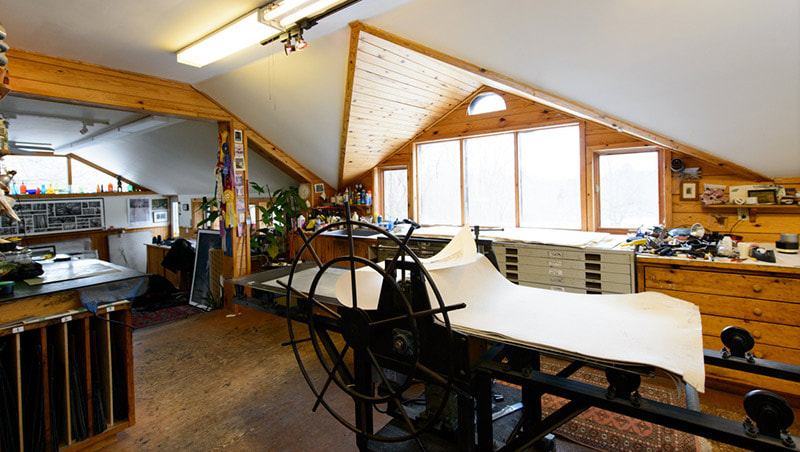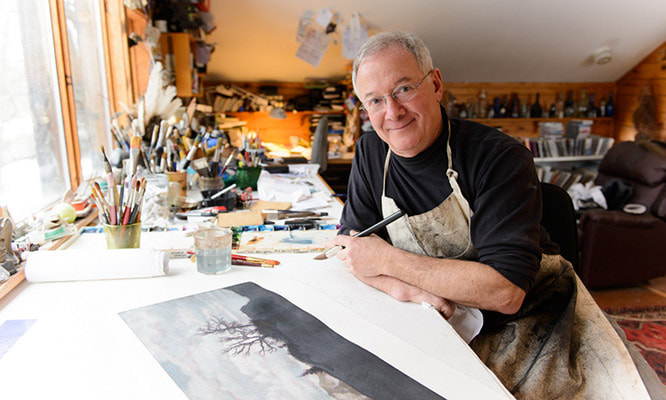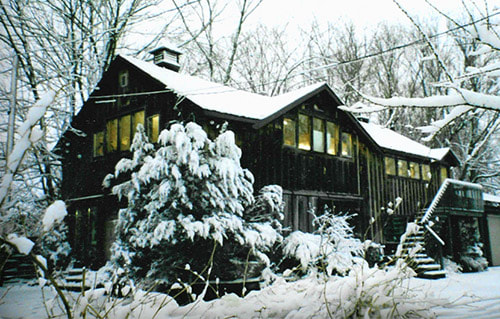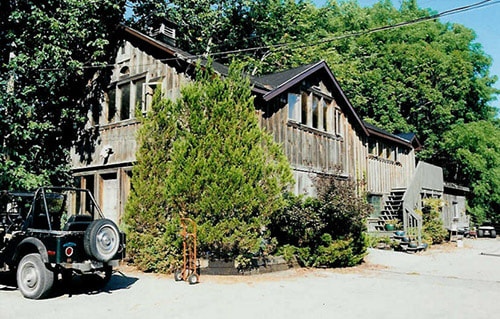About George - A Profile
This article by Fran Fernley, originally appeared in Art Impressions magazine
IT'S A MOBILE OF SORTS. Tacked onto the sloped ceiling over the desk in George Raab's studio, papers of every size flutter in the fall breeze. Most prominent is a timetable faded and curling at the edges. It begins: 7:00 am - 9:00 am Exercise, Light Stove, Animal Chores, Shower, Breakfast. Every waking hour is carefully accounted for. Raab laughingly admits that despite its five year presence on the ceiling, "I don't think I've ever really followed the schedule." There are a few receipts, newspaper clippings, an address scribbled on a brown paper bag, a homemade calendar for September and correspondence to and from art galleries as far away as Taipei in China.
IT'S A MOBILE OF SORTS. Tacked onto the sloped ceiling over the desk in George Raab's studio, papers of every size flutter in the fall breeze. Most prominent is a timetable faded and curling at the edges. It begins: 7:00 am - 9:00 am Exercise, Light Stove, Animal Chores, Shower, Breakfast. Every waking hour is carefully accounted for. Raab laughingly admits that despite its five year presence on the ceiling, "I don't think I've ever really followed the schedule." There are a few receipts, newspaper clippings, an address scribbled on a brown paper bag, a homemade calendar for September and correspondence to and from art galleries as far away as Taipei in China.
George's hometown of MillbrookThe real focus of this studio is, however; elsewhere. It's in the hand-operated press, the darkroom, the precision hand tools, the acids and lump rosin, the metal plates, the sketches and photographs, the printer's ink and the palate of watercolours. But most of all it's in the hands, head and heart of George Raab. Raab is an intaglio printmaker whose powerful images of the Canadian wilderness have earned him recognition and awards provincially, nationally and around the globe. He made his choice after working in several different mediums. Raab jokes that his childhood years were spent in the basement where, in a room next to the furnace, he 'copied' the Great Masters. Later he packed his sketch pad and camera and traveled extensively in Africa, Europe and the Canadian Arctic. Now, married and father to two sons, he marvels at the joy of living in a vibrant community in rural Ontario. Raab's work is not benign, pastoral, wildlife art. Tamed, tidy landscapes don't excite him. He looks for; finds and faithfully represents dense, tangled forests which are rarely subjected to the sound of the chainsaw. The panoramas have no hint of domesticity. Ancient rocks are etched only with the marks of nature's erosion. Bogs are stagnant; they fester with organic decay. There are two very separate aspects to the creation of a limited edition of Raab's original prints. It all begins somewhere else. Maybe in a remote corner of British Columbia's Queen Charlotte Islands or perhaps several lakes and portages away from 'civilization' in northern Ontario. "I have tried other subjects but I keep returning to the wilderness. That's where I feel most comfortable," Raab muses, "it moves me in a way nothing else can. It is our best teacher. I believe that if we let ourselves respond to nature -- fully -- then we develop a sense of perspective and become more in tune with ourselves." Sketches are made for composition and to capture the atmosphere and Raab's personal reactions. Photographs are taken to record detail. He also keeps a dairy which he calls "a sort of crude, emotional poetry" He may pocket a little memento; a fragment of bark, a piece of driftwood, a puffball. But Raab disturbs nothing. He's a passionate conservationist.
Back in his Millbrook studio which overlooks home -- ten acres, a gracious century home and a pasture of horses and assorted, exotic poultry -- Raab starts to sift through his on-site material. The intaglio process is complex and time consuming. There is no room for false starts. Raab must be aesthetically sure of his image before the first mark is made on the metal plate. But it is not only composition which must be clearly defined. Raab must now decide whether to work exclusively on the plate or, instead, expose a hand-manipulated photographic positive on high contrast film onto the metal. Either way the work has only just begun. "I incise and bite my image below the surface of the copper or zinc plate, creating grooves and textures. The ink is wiped from the surface and stays trapped in the areas which have been removed by tools and acids." Lines are made through etching, as it allows for spontaneity. The plate is 'protected' with a hard ground, a sort of acid-resistant wax. Using an etching needle he draws through the ground exposing the metal beneath it. Then the plate is immersed in an acid bath and the lines which have been drawn are bitten or etched away. "The longer it stays in the acid," Raab explains, "the deeper the bite, the more ink it will hold and the darker the resulting tone will be.With intaglio the ink sits right up on the paper and a really deep bite creates a raised area which almost casts shadows."
Back in his Millbrook studio which overlooks home -- ten acres, a gracious century home and a pasture of horses and assorted, exotic poultry -- Raab starts to sift through his on-site material. The intaglio process is complex and time consuming. There is no room for false starts. Raab must be aesthetically sure of his image before the first mark is made on the metal plate. But it is not only composition which must be clearly defined. Raab must now decide whether to work exclusively on the plate or, instead, expose a hand-manipulated photographic positive on high contrast film onto the metal. Either way the work has only just begun. "I incise and bite my image below the surface of the copper or zinc plate, creating grooves and textures. The ink is wiped from the surface and stays trapped in the areas which have been removed by tools and acids." Lines are made through etching, as it allows for spontaneity. The plate is 'protected' with a hard ground, a sort of acid-resistant wax. Using an etching needle he draws through the ground exposing the metal beneath it. Then the plate is immersed in an acid bath and the lines which have been drawn are bitten or etched away. "The longer it stays in the acid," Raab explains, "the deeper the bite, the more ink it will hold and the darker the resulting tone will be.With intaglio the ink sits right up on the paper and a really deep bite creates a raised area which almost casts shadows."
Raab has always been fascinated by tone. In fact until he started using watercolour, his monochromatic tonal values he says, "gave the illusion of colour." It's a quality he has not relinquished since he picked up the paintbrush. Aquatinting is Raab's preferred tonal process. It's an 18th century technique, so-called because artists used it to create the effects of watercolour wash drawings. The plate is dusted with crushed lump rosin and then heated (in Raab's case over a lethal-looking hotplate). The rosin particles fuse and each tiny droplet becomes an acid resistant dot. Then the plate is submerged in the acid bath. As with etching the 'unprotected' areas are bitten away.
A current test chart hangs above the acid tray for reference. A five-second exposure creates a faintly perceptible gray tone when printed. A 20-minute exposure is a deep black. "I can achieve a wide range of tones by removing the plate any number of times and 'stopping out' the areas which I don't want the acid to work on any more," says Raab, "But it requires careful timing and I have to know exactly what tonal variations I want." Once Raab is satisfied with the image (it mirrors what will appear on paper) he wants to print, then he pulls a series of artists proofs. He will vary the wiping of ink and determine the amount of pressure to be applied by the press' rollers before he finds the right combination. "People tend to think of printmaking as a uniform process," says Raab. "But with intaglio that's not the case. Each print is individually inked and wiped and pulled by hand. There's a real sense of brilliance and texture with an original print that you can never achieve with reproductions."
For many years Raab considered introducing colour but it was not until he had worked monochromatically for almost 10 years that he felt ready. "I was looking for a way to express myself more specifically in terms of atmosphere, season and the time of day. I toyed with adding colour through the printmaking process but I found that watercolour gave me what I was looking for -- a very soft, elusive wash-like quality. I didn't want to paint my etchings but rather to enhance the details. Colour has allowed me to give more depth in terms of emotional values and has sharpened my perspective."
A current test chart hangs above the acid tray for reference. A five-second exposure creates a faintly perceptible gray tone when printed. A 20-minute exposure is a deep black. "I can achieve a wide range of tones by removing the plate any number of times and 'stopping out' the areas which I don't want the acid to work on any more," says Raab, "But it requires careful timing and I have to know exactly what tonal variations I want." Once Raab is satisfied with the image (it mirrors what will appear on paper) he wants to print, then he pulls a series of artists proofs. He will vary the wiping of ink and determine the amount of pressure to be applied by the press' rollers before he finds the right combination. "People tend to think of printmaking as a uniform process," says Raab. "But with intaglio that's not the case. Each print is individually inked and wiped and pulled by hand. There's a real sense of brilliance and texture with an original print that you can never achieve with reproductions."
For many years Raab considered introducing colour but it was not until he had worked monochromatically for almost 10 years that he felt ready. "I was looking for a way to express myself more specifically in terms of atmosphere, season and the time of day. I toyed with adding colour through the printmaking process but I found that watercolour gave me what I was looking for -- a very soft, elusive wash-like quality. I didn't want to paint my etchings but rather to enhance the details. Colour has allowed me to give more depth in terms of emotional values and has sharpened my perspective."
Intaglio is an exacting art form. To retain a high-level of involvement in a piece that takes perhaps a month from concept to completion requires a special kind of discipline. Raab feels that despite the "incubation period" and the technical processes, intaglio is a deeply spontaneous form of expression. "The medium itself has something to say and I never know exactly what it is until I peel the print from the plate. There are always surprises."
These wilderness cameos are meticulously realistic. Raab has no desire to alter the landscape he knows and loves so well. But in the realism he offers a spiritual interpretation. The cycle of life, growth, decay and death are confronted without equivocation. For Raab this is where it all began and this is where we should turn if we expect to find ourselves. It's best expressed in the words he wrote one day sitting beside a pool dotted with giant lily pads. "It is in this mystical bog we separate realities on stumptops. And as the mist sets in, return to the same conclusions -- the point where it all began. Where animals are, and life is not a gift. Where freedom is not another word, and the unknown prevails."
These wilderness cameos are meticulously realistic. Raab has no desire to alter the landscape he knows and loves so well. But in the realism he offers a spiritual interpretation. The cycle of life, growth, decay and death are confronted without equivocation. For Raab this is where it all began and this is where we should turn if we expect to find ourselves. It's best expressed in the words he wrote one day sitting beside a pool dotted with giant lily pads. "It is in this mystical bog we separate realities on stumptops. And as the mist sets in, return to the same conclusions -- the point where it all began. Where animals are, and life is not a gift. Where freedom is not another word, and the unknown prevails."





